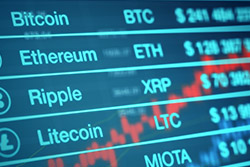
The findings from the Economist Intelligence Unit (EIU) study, sponsored by Crypto.com, showed 20 per cent of people do not currently use digital currencies such as bitcoin, but they plan to in the next year.
Physical credit cards were shown to be the most popular payment choice overall, while cash was only the third-most used option.
Digital currencies, including cryptocurrencies such as bitcoin, ether and XRP, were still the least cited option but they captured the largest share of respondents who planned to try it in the next 12 months. The survey suggested that even prior to the pandemic, societies across the world were already leaning towards cashless options for daily purchases, based on convenience and traceability reasons.
Jason Wincuinas, senior editor for thought leadership with the EIU, headed the research, which consulted with Eva Julin, deputy head general secretariat at Sveriges Riksbank (Sweden’s central bank) and Antony Lewis, fintech adviser to The Securities and Futures Commission (SFC) of Hong Kong.
“COVID-19 wasn’t part of the original survey parameters since it didn’t exist at the survey’s onset,” Mr Wincuinas commented.
“But we can see in events since the survey finished in February – such as debate in the US congress over introducing a ‘digital dollar’ in recent weeks – that this is becoming a structural concern for society.
“What’s interesting is how China and Sweden were already looking at digital currency as potential pillars of their monetary systems. For other countries, maybe it takes an emergency like COVID-19 to move the needle.”
The EIU reported that 85 per cent of global consumers have owned, used or heard of decentralised digital currency such as cryptocurrency. In the developing world, awareness reached 92 per cent.
Around 34 per cent of respondents in the survey considered online payments to be digital currency’s main function, while only 24 per cent cited “short-term investment” as a reason for its use.
Around 54 per cent of respondents said they would consider a digital currency issued by their government trustworthy, compared to only 26 per cent who said the same about currently available cryptocurrencies.
However, cryptocurrency was the most recognised digital currency in the study.
Mr Wincuinas added the trend towards cashless payments is “an irresistible force”.
“It was very interesting to observe greater eagerness and expectations within the developing economies we tested,” he said.
“Given that these countries also tend to have higher rates of people using mobile devices to go online and younger populations – who also tend to have faster take-up of technology generally – it could be a harbinger of what’s to come with digital currencies.
“Combined with the fact that we saw more resistance to cryptocurrencies and digital payments in developed economies, I think it’s clear there could be another leapfrog effect in the waiting as economies like China push ahead with digital ways to pay, and economies with older payment infrastructures play a wait-and-see game. But COVID-19 could change everything.”





